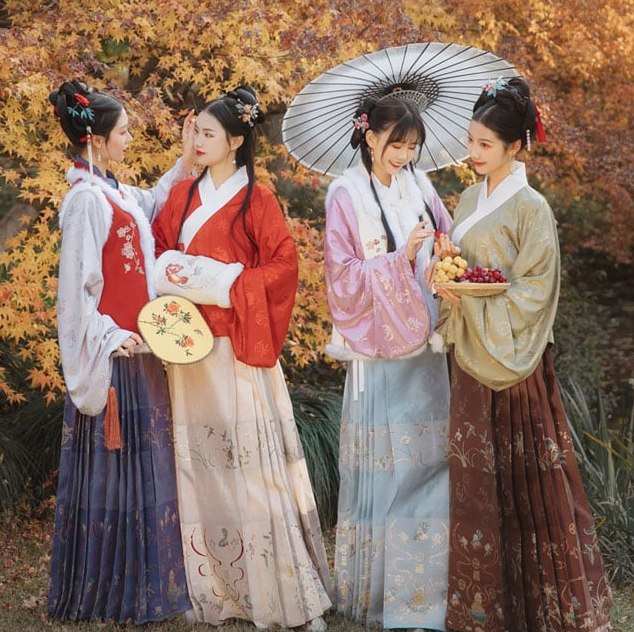The most popular Hanfu style is the Tang Dynasty-style Aoqun, known for its elegance and versatility.
Introduction to Hanfu
Hanfu, the traditional attire of the Han Chinese people, boasts a rich and diverse history that dates back over three millennia. This elegant clothing style reflects the aesthetic preferences and cultural values of ancient China. The term “Hanfu” itself translates to “Han clothing,” where “Han” refers to the dominant ethnic group in China. Often characterized by its cross-collar, wrapping the right side over the left, and wide sleeves, Hanfu has evolved through dynasties, each adding unique elements to its design.
Historical Origin of Hanfu
Tracing its roots, Hanfu first emerged during the Han Dynasty (206 BC – 220 AD). This period witnessed the standardization of Hanfu as a symbol of Han identity. The clothing style was influenced by the philosophies of Confucianism, emphasizing modesty and ritual. Over time, Hanfu evolved, incorporating various styles from different dynasties like the Tang, Song, and Ming, each known for their distinct contributions to Hanfu’s evolution.

Cultural Significance in Modern Times
In modern times, Hanfu has experienced a resurgence, especially among young people, as a way to connect with and express their cultural heritage. It has become a significant part of festivals, cultural events, and even daily fashion for some. This revival also signifies a broader movement towards appreciating traditional Chinese culture and history. The influence of Hanfu extends beyond fashion, touching on aspects of art, literature, and social practices, symbolizing a bridge between the past and present of Chinese culture.
Analyzing Popularity Trends
The popularity of Hanfu has seen a notable surge in recent years. Researchers and fashion analysts use various methods to track this trend, including social media analysis, sales data, and consumer surveys. These methods reveal a growing interest in traditional attire among younger generations. The trend is not just limited to China; it’s gaining traction globally, thanks to the internet and increased cultural exchange.
Surveying Fashion Influences
Fashion influences play a crucial role in the resurgence of Hanfu. Designers often draw inspiration from historical sources, combining them with modern aesthetic sensibilities. For instance, traditional patterns find new life in contemporary fabric choices. Additionally, fashion influencers and celebrities embracing Hanfu styles on social media platforms have significantly contributed to its popularity. These platforms become a stage for showcasing Hanfu’s versatility and elegance, appealing to a broad audience.
Media and Entertainment Impact
The media and entertainment industries have been instrumental in popularizing Hanfu. Historical dramas and films set in ancient China often feature exquisite Hanfu costumes, sparking viewer interest. These productions not only showcase the beauty of Hanfu but also provide a glimpse into its historical context. Furthermore, cultural festivals and events that celebrate Chinese heritage often feature Hanfu, providing a tangible connection to Chinese history and traditions.
Varieties of Hanfu Styles
Hanfu encompasses a wide array of styles, each reflecting different historical periods and aesthetic values. From the simple, elegant lines of the Shang dynasty to the intricate, layered looks of the Ming dynasty, Hanfu offers a rich tapestry of designs. This diversity reflects the evolution of Chinese culture over centuries. Today, enthusiasts can choose from a multitude of styles, each telling its own story of China’s past.
Traditional vs. Contemporary Designs
The distinction between traditional and contemporary Hanfu designs lies in their adherence to historical accuracy and modern adaptation. Traditional Hanfu stays true to the styles, materials, and making techniques of ancient times. In contrast, contemporary Hanfu designs infuse modern elements, such as new fabrics and updated cuts, while maintaining the essence of traditional aesthetics. This fusion creates garments that honor the past while fitting comfortably in modern life.
Regional Variations and Influences
Regional variations in Hanfu styles reflect the diverse cultural landscape of China. Different geographical areas have developed unique styles based on local climate, resources, and cultural influences. For example, Hanfu from the northern regions often features heavier fabrics and darker colors, suitable for cooler climates. Meanwhile, southern styles favor lighter materials and brighter colors, reflecting the warmer, more humid environment. These regional differences contribute to the rich diversity of Hanfu.
Factors Influencing Hanfu Popularity
Several factors contribute to the growing popularity of Hanfu. These include a renewed interest in traditional culture among younger generations, the influence of media and entertainment, and the rise of national pride. Each of these factors plays a significant role in bringing Hanfu into the mainstream, turning it from a niche interest into a widely recognized fashion trend.
Role of Social Media and Online Communities
Social media and online communities have been pivotal in popularizing Hanfu. Platforms like Weibo, TikTok, and Instagram allow enthusiasts to share photos, styling tips, and information about Hanfu. Online forums and communities provide spaces for discussion, exchange of ideas, and planning of meet-ups and events. These digital platforms have created a global community of Hanfu enthusiasts, transcending geographical boundaries.
Fashion Industry and Designer Innovations
The fashion industry has responded to the Hanfu trend with enthusiasm. Designers are experimenting with new materials, colors, and styles to modernize Hanfu while respecting its historical roots. These innovations make Hanfu more accessible and wearable in daily life. For example, incorporating modern fabrics makes the garments easier to care for, while design tweaks allow for greater mobility and comfort, broadening Hanfu’s appeal to a modern audience.
Consumer Preferences and Market Analysis
Consumer preferences in the Hanfu market reveal a fascinating blend of cultural heritage and modern fashion sensibilities. Younger generations are particularly drawn to Hanfu, seeing it as a way to express their identity and connect with traditional Chinese culture. Preferences vary widely, from those seeking authentic, historically accurate garments to those who favor modern, stylized versions that are easier to wear in everyday life.
Demographic Trends in Hanfu Consumption
The demographic trend in Hanfu consumption predominantly involves younger consumers, notably those in their twenties and thirties. This group is tech-savvy and heavily influenced by social media trends. They also show a strong interest in cultural activities and are more likely to participate in traditional festivals and events where Hanfu is worn. Gender-wise, while women are the primary consumers, there is a growing interest among men, reflecting a broader acceptance and appreciation of Hanfu.
Market Analysis and Sales Data
Market analysis indicates a robust growth in the Hanfu industry, with sales figures consistently rising over the past few years. Online platforms are the primary sales channels, offering a wide variety of Hanfu styles at different price points. This accessibility has significantly boosted sales. High-quality, authentic Hanfu garments can be expensive, reflecting the craftsmanship and materials used, while more affordable, stylized versions cater to those on a tighter budget.

Future of Hanfu Fashion
The future of Hanfu fashion seems bright and dynamic, with trends indicating a growing global interest. This interest is not only in traditional designs but also in innovative styles that blend old and new elements. The ongoing fascination with Chinese culture and history, especially among the youth, suggests that Hanfu will continue to evolve and gain popularity.
Predicting Trends and Changes
Predicting future trends in Hanfu fashion points towards greater integration with contemporary styles. This integration could include the use of new materials and technologies to enhance comfort and wearability. Additionally, we may see Hanfu-inspired elements in mainstream fashion, as designers globally draw inspiration from its rich aesthetic. This blend of tradition and innovation will likely keep Hanfu relevant and appealing to a broad audience.
Hanfu in Global Fashion
Hanfu’s presence in global fashion is steadily increasing. International fashion shows and cultural exchanges are introducing Hanfu to a wider audience. Moreover, as global interest in diverse cultural fashions grows, Hanfu stands out for its unique history and aesthetic. This rising global profile could lead to more collaborations between Chinese and international designers, potentially making Hanfu a staple in the global fashion scene.







